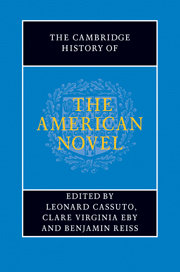Book contents
- Frontmatter
- General Introduction
- PART ONE INVENTING THE AMERICAN NOVEL
- PART TWO REALISM, PROTEST, ACCOMMODATION
- PART THREE MODERNISM AND BEYOND
- PART FOUR CONTEMPORARY FORMATIONS
- Introduction: contemporary formations
- 58 Postmodern novels
- 59 The nonfiction novel
- 60 Disability and the American novel
- 61 Model minorities and the minority model – the neoliberal novel
- 62 The American borderlands novel
- 63 The rise of the Asian American novel
- 64 Toni Morrison and the post-civil rights African American novel
- 65 Hemispheric American novels
- 66 The worlding of the American novel
- 67 The Native American Tradition
- 68 Contemporary ecofiction
- 69 Graphic novels
- 70 Twentieth- and twenty-first-century literary communities
- 71 A history of the future of narrative
- A selected bibliography
- Index
69 - Graphic novels
from PART FOUR - CONTEMPORARY FORMATIONS
Published online by Cambridge University Press: 28 July 2011
- Frontmatter
- General Introduction
- PART ONE INVENTING THE AMERICAN NOVEL
- PART TWO REALISM, PROTEST, ACCOMMODATION
- PART THREE MODERNISM AND BEYOND
- PART FOUR CONTEMPORARY FORMATIONS
- Introduction: contemporary formations
- 58 Postmodern novels
- 59 The nonfiction novel
- 60 Disability and the American novel
- 61 Model minorities and the minority model – the neoliberal novel
- 62 The American borderlands novel
- 63 The rise of the Asian American novel
- 64 Toni Morrison and the post-civil rights African American novel
- 65 Hemispheric American novels
- 66 The worlding of the American novel
- 67 The Native American Tradition
- 68 Contemporary ecofiction
- 69 Graphic novels
- 70 Twentieth- and twenty-first-century literary communities
- 71 A history of the future of narrative
- A selected bibliography
- Index
Summary
“Comics are suddenly everywhere,” claims Jared Gardner in one of the many scholarly essays that have been devoted to this cultural form in recent years. And one of the places they are is certainly literature, more particularly the novel. It has now become perfectly thinkable that future editions of the Norton anthology or one of its many competitors will have a section on graphic novels. This situation is fairly new, for if comics have been knocking at literature's door for many decades now, where they occupy one of the niches of so-called paraliterature, the association with the novel is more topical. Of course, there has always been a flourishing branch of comics that specializes in the adaptation of literary material (Moby-Dick may be the best-represented example), but these productions were not considered literary works themselves –despite the undeniable quality of some of these adaptations. On the contrary, books like Will Eisner's A Contract with God (1978), Harvey Pekar's series American Splendor (seventeen issues, written between 1976 and 1993), Art Spiegelman's Maus (two volumes, 1986–1991), Daniel Clowes's Ghost World (1997), Chris Ware's Jimmy Corrigan (2000), Adrian Tomine's Sleepwalk (2002), Charles Burns's Black Hole (2005), to name just a few (though far from arbitrarily chosen), are nowadays often read as novelistic productions, albeit of a special kind.
How has this become possible, and what does it mean? Within the field of comics, it appears that a subgenre has emerged – the graphic novel – and its status has shifted from paraliterary to literary. Such an answer, which is not false per se, raises many other questions.
- Type
- Chapter
- Information
- The Cambridge History of the American Novel , pp. 1137 - 1153Publisher: Cambridge University PressPrint publication year: 2011
- 4
- Cited by



